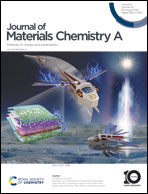Pseudo-bilayered inverted organic solar cells using the Marangoni effect†
Abstract
The randomly mixed morphology of donor and acceptor materials in organic solar cells (OSCs) has been perceived as a breakthrough in the development of OSCs. By contrast, the vertically separated donor and acceptor structures of OSCs allow each material to be optimized separately, which facilitates charge extraction within OSCs and reduces charge recombination. Moreover, the morphological robustness of phase separation in OSCs can enhance their stability. However, sequential solution coating typically requires an orthogonal solvent to prevent the destruction of the bottom layer, and identifying the appropriate solvents is challenging. In addition, a quasi-orthogonal solvent (e.g., volatile solvent) requires a polymer bottom layer that can withstand the solvent during the sequential coating. In this study, we construct a bilayer structure using a small molecule (Y7-BO) as a bottom layer and a polymer (PM6) as a top layer. The PM6 layer is formed on water via the Marangoni phenomenon and directly stamped onto the Y7-BO layer. To develop a pseudo-bilayer (PB) architecture, we incorporate a low-volatility solvent additive into the polymer solution and allow the additive to reside within the bilayer. An appropriately low amount of solvent additive (chloronaphthalene) is added to optimize intermixing at the donor/acceptor interface, which reinforces the face-on molecular orientation of the active layers. Consequently, a power conversion efficiency of 17.12% is achieved by the inverted OSC with a PB architecture, which is higher than that achieved by its bulk heterojunction counterparts.

- This article is part of the themed collection: #MyFirstJMCA


 Please wait while we load your content...
Please wait while we load your content...